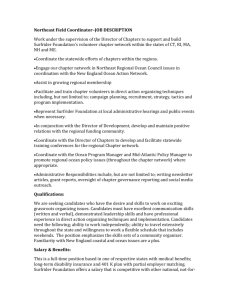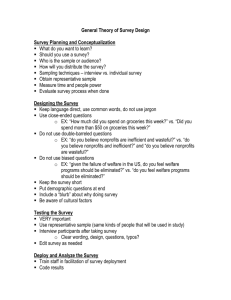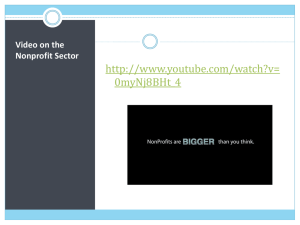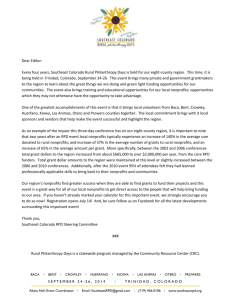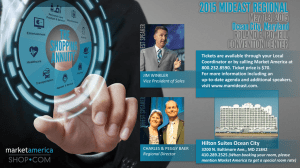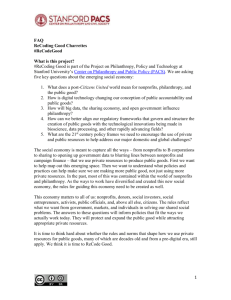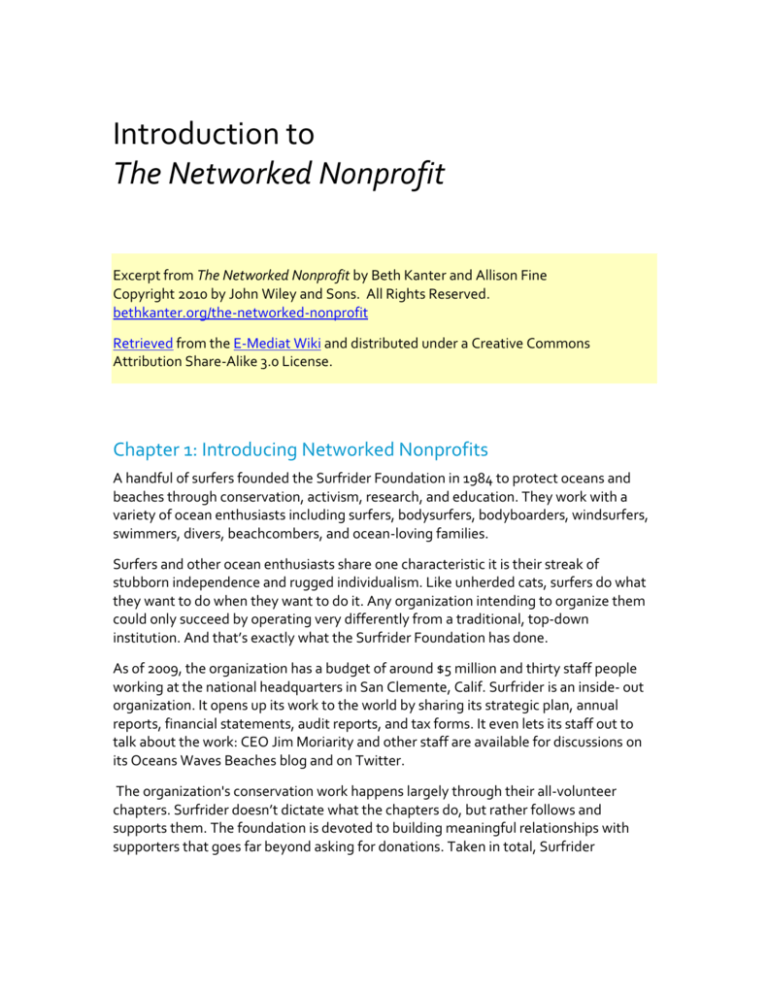
Introduction to
The Networked Nonprofit
Excerpt from The Networked Nonprofit by Beth Kanter and Allison Fine
Copyright 2010 by John Wiley and Sons. All Rights Reserved.
bethkanter.org/the-networked-nonprofit
Retrieved from the E-Mediat Wiki and distributed under a Creative Commons
Attribution Share-Alike 3.0 License.
Chapter 1: Introducing Networked Nonprofits
A handful of surfers founded the Surfrider Foundation in 1984 to protect oceans and
beaches through conservation, activism, research, and education. They work with a
variety of ocean enthusiasts including surfers, bodysurfers, bodyboarders, windsurfers,
swimmers, divers, beachcombers, and ocean-loving families.
Surfers and other ocean enthusiasts share one characteristic it is their streak of
stubborn independence and rugged individualism. Like unherded cats, surfers do what
they want to do when they want to do it. Any organization intending to organize them
could only succeed by operating very differently from a traditional, top-down
institution. And that’s exactly what the Surfrider Foundation has done.
As of 2009, the organization has a budget of around $5 million and thirty staff people
working at the national headquarters in San Clemente, Calif. Surfrider is an inside- out
organization. It opens up its work to the world by sharing its strategic plan, annual
reports, financial statements, audit reports, and tax forms. It even lets its staff out to
talk about the work: CEO Jim Moriarity and other staff are available for discussions on
its Oceans Waves Beaches blog and on Twitter.
The organization's conservation work happens largely through their all-volunteer
chapters. Surfrider doesn’t dictate what the chapters do, but rather follows and
supports them. The foundation is devoted to building meaningful relationships with
supporters that goes far beyond asking for donations. Taken in total, Surfrider
resembles a social network rather than a traditional stand-alone organization. We call
Surfrider and organizations like it a Networked Nonprofit.
In 2008, the Surfrider network included over 70 Surfrider chapters located along the
East, West, Gulf, Hawaiian, and Puerto Rican coasts. The organization had over 50,000
paying members and many more thousands of local volunteers. In addition to the local
chapters, several hundred groups and pages on Facebook were dedicated to Surfrider
and its local chapters.
Each chapter works on what the organization calls “atom-based work” on land and “bitbased work” online. The atom-based work includes organizing beach clean ups, testing
beach waters, and conducting local education programs. The bit-based work involves
lots of conversations on a variety of social media channels like Facebook and Twitter,
sending out email action alerts, and organizing events online.
Surfrider has created a unique model of engagement to map the participation of
volunteers from strangers to friends to supporters, members, activists, and leaders. The
organization provides an array of ways for people to participate at every level.
Strangers and friends can buy t-shirts online and sign up for email alerts. More involved
supporters and members can download and listen to podcasts and organize local beach
clean-ups. Leaders can arrange to meet with elected officials to discuss legislation to
protect the shorelines.
Like surfers, the chapters do what they want to do when they want to do it. The
Foundation trusts their distributed network of people to work on its behalf without
requiring constant oversight. Chad Nelson, Surfrider’s Environmental Director, said that
while this might annoy the lawyers, the national office rarely polices or intervenes with
what the chapters are doing.
And it all works to engage people locally and energetically on behalf of the
organization. In 2008, Surfrider had over 200 community outreach campaigns, over 900
local presentations of its Respect the Beach education program, over 8,000 beach
water tests taken, and over 600 beach clean ups. Surfrider Chapter representatives
attended over 125 meetings and events involving city, county, and state governments.
In total, volunteers contributed over 145,000 volunteer hours.1
1
Beth Kanter, “Mapping Your Online/Offline Activism: Surfrider Foundation,” Beth’s Blog, posted April 6, 2009,
http://beth.typepad.com/beths_blog/2009/04/mapping-your-onlineoffline-activism-surfrider-foundation.html (accessed August
2, 2009).
The Surfrider Foundation ignites the passions of thousands of ocean enthusiasts. In
return, this network of participants shares its energy and enthusiasm for Surfrider with
their own personal networks of friends, volunteers their time, and donates money to
support the organization.
About Networked Nonprofits
Networked Nonprofits are simple and transparent organizations. They are easy for
outsiders to get in and insiders to get out. They engage people to shape and share their
work in order to raise awareness of social issues, organize communities to provide
services or advocate for legislation. In the long run, they are helping to make the world
a safer, fairer, healthier place to live.
Networked Nonprofits don’t work harder or longer than other organizations, they work
differently. They engage in conversations with people beyond their walls — lots of
conversations — to build relationships that spread their work through the network.
Incorporating relationship building as a core responsibility of all staffers fundamentally
changes their to-do lists. Working this way is only possible because of the advent of
social media. All Networked Nonprofits are comfortable using the new social media
toolset — digital tools such as email, blogs, and Facebook that encourage two-way
conversations between people, and between people and organizations, to enlarge their
efforts quickly, easily and inexpensively.
We know nonprofit staffs often feel over-burdened, with too much pressure on too few
people to do too much. As we will discuss in Chapter 7: Making Organizations Simpler,
nonprofits and the people within them have too much to do because they try to do too
much as stand alone organizations. Networked Nonprofits know their organizations are
part of a much larger ecosystem of organizations and individuals that are all incredible
resources for their efforts.
Networked Nonprofits are not afraid to lose control of their programs and services,
their logos and branding, messages and messengers because they know that in return
they will receive the goodwill and passion of many people working on their behalf.
Working this way enables these organizations to reach many more people less
expensively than they ever could be working largely alone
Some organizations like the Surfrider Foundation, and others that we’ll discuss in this
book, like MomsRising and charity:water, are born as Networked Nonprofits. But being
Networked Nonprofits is not just an accident of birth. Any organization can become
one, and many are in the process of doing so. Venerable nonprofit organizations like
the American Red Cross, the Humane Society of the United States, Planned
Parenthood, and the American Cancer Society, are turning themselves inside out with
great success. We will share their stories, struggles, and lessons throughout this book in
order to encourage other organizations become Networked Nonprofits.
But organizations are not the only entities powering social change in this new,
connected world. Individuals — we call them free agents – combine their social media
savvy with their passion for social causes to accomplish amazing things. Free agents’
facility with social media gives them the power and tools that only organizations had
just a few years ago. They. And they are pushing nonprofit organizations to become
Networked Nonprofits.
The Social Media Revolution
Evolutions are incremental improvements of a product or idea. The newest Ford
Mustang or iPod may be better iterations than previous versions, but they are still
fundamentally the same product. When two teenagers, Shawn Fanning and Sean
Parker, created the online music-sharing site Napster in 1999, they sparked a
revolution. Power shifted away from music companies towards music listeners. For the
first time, consumers had the ability to shape their own collection of songs any way
they wanted, and perhaps more importantly, share these songs with the world online.
It wasn’t legal, it still isn’t, but it was inevitable given that millions of people could easily
and inexpensively access and use the tools. Even if services like iTunes slows down the
free sharing of music files online, it will never erase it entirely. The genie has popped
out of the bottle, and she won’t be put back in. Social media are revolutionary in their
power and reach.
In the 1980s, personal computers landed on everyone’s desk and changed the way
information was stored and organized. In the 1990s, the World Wide Web connected a
universe of people and made information accessible. This century has seen the rise of
the social graph — the relationships people are making and renewing using social
media tools, particularly social networking sites, enables rapid, collective activity.
We define social media as the array of digital tools such as instant messaging, text
messaging, blogs, videos, and social networking sites like Facebook and MySpace that
are inexpensive and easy to use. Social media enable people to create their own stories,
videos, and photos, to manipulate them and share them widely at almost no cost.
Included in this book is a glossary to provide more definitions of specific tools and
processes.
Social media tools integral to nonprofits fall into three general categories of use:
Conversation starters like blogs, YouTube, and Twitter
Collaboration tools including wikis and Google Groups
Network builders like social networking sites such as Facebook, Myspace, and
Twitter
Social media are not a fad or a trend. With near universal access to the World Wide Web
in the United States, and the ubiquity of mobile phones and email, the use of social
media will only continue growing. Social media use is becoming ingrained in the way
that people relate to one another and work together. In particular, social media are
shaping the way that young people think, connect, engage, and work together.
We want to caution readers that knowing how to use social media well is not just about
knowing which button to push. Technological wizardry shouldn’t overshadow the truly
revolutionary power of social media, which is its ability to connect people to one
another and help build strong, resilient, trusting relationships. But the only way to
understand this distinction is to use the toolset personally. There is no other way to
fully understand the power of using social media to connect friends and strangers with
common interests than to experience it personally. In other words: Social media use is a
contact sport, not a spectator sport.
We also warn you that there is no universal rule about which tool will work under which
circumstances for which people. Networked Nonprofits do not use just one tool. They
use many tools to engage in different kinds of conversations with different groups of
people.
More importantly, keep in mind that tools will come and go, but strategy sustains
organizations. Choosing and using any specific tool is less important to organizational
success than embracing the principles and strategies that make social media effective.
Using social media is a way of being more than a way of doing.
Unfortunately, too many nonprofit organizations are losing ground today because they
fear what might happen if they open themselves up to this new world. These
organizations are crashing into this set-me-free world powered by social media,
unprepared to become Networked Nonprofits. Many These fears are unfounded. Let's
begin by facing and overcoming the fears and myths about social media use that simply
aren’t true.
Busting the Social Media Myths
The array of social media tools look complex from the outside, a beeping, flashing,
chattering din. Watching young people glide through the social media world with ease
adds to the perception that social media are only for the technologically savvy or young
people. Neither perception is true. But you don’t have to take our word for it; we’ll let
Peggy Padden explain.
Fate dealt Peggy’s family the cruelest blow when two of her three sons were born with
a genetic blood disorder called Fanconi Anemia (FA), which leads to bone marrow
failure. Her oldest son died after a failed bone marrow transplant, while her younger
son is still fighting the disease. But Peggy by nature is a doer, so she energetically
began to raise money for the Fanconi Anemia Research Fund to help find a cure for this
terrible disease. She organized 5k runs/walks on Valentines Day and golf tournaments
to raise money in Portland, Ore., where she lives.
In December 2007, Peggy saw an article in PARADE Magazine about a new fundraising
contest called America’s Giving Challenge. The Case Foundation, the family
philanthropy started by AOL founder Steve Case and his wife Jean, sponsored the
Challenge. They encouraged individuals to join the Challenge by signing up online at
PARADE Magazine’s site or on Facebook.
Over a fifty-day period, these individuals, or champions, competed to raise the largest
number of people to give at least $10 each for their cause. The eight champions that
raised the largest number of friends during the contest would win the money they
raised, plus $50,000 from the Case Foundation.
Peggy’s reaction when she read the challenge description was, “That’s a lot of money!”
And since she was always looking for new ways to raise money for FA, she decided to
give it a try.
Peggy was the first to admit that all the newfangled technology tools — all of that
“Face page stuff” in her words — was not meant for a fifty-year-old woman like her. She
knew enough to get by, she thought. She read and sent email, surfed the Web a bit, and
was very excited when she learned how to cut and paste in a Word document. But that
was it; she left the rest for her children. That is what made Peggy’s success in America’s
Giving Challenge, a fundraising effort that hinged on using new social media tools like
Facebook, such a huge surprise.
A few clicks on the PARADE Magazine website and Peggy had registered her cause for
the Challenge and added her name as the champion. “I was a beginner, I’ve never done
anything like a badge before,” she says. “I was able to figure it out except for the
picture, I couldn’t get it any bigger.” She waited for her son to get home to fix the
photo.
Once she set up the badge, Peggy began to do what she felt most comfortable doing:
She emailed her family, friends, acquaintances, and the 250 families on the Fanconi
Anemia listserv, asked them to become a friend to her cause, and donate $10. It was a
long shot, she said, but they could possibly win $50,000 and that the money would go
towards our only hope for a cure for Fanconi Anemia. She also asked them to e-mail
everyone they knew about the Challenge. And they did.
Word began to spread online about Peggy’s cause. As she recalled, “That 6 degree of
separation part was right on. I would hear from someone who knew someone who
knew someone who had emailed everyone they knew. It spread like wildfire.”2
Her cause had gone viral, meaning friends of friends were doing things on her behalf
without Peggy having to ask them to do so directly. To Peggy’s astonishment, people
she didn’t know put the Fanconi Anemia cause up on their Facebook pages, on their
blogs, and on MySpace. It was time for Peggy to put aside her fears and anxiety about
social media and just jump into the maelstrom on Facebook and everywhere else the
conversation about her cause was happening.
Peggy had no overall plan and no marketing budget. She and her friends just kept going
and doing, and somehow it all worked. She wasn’t quite sure what people were doing
and saying on her behalf, but it didn’t matter. The results were clear, many people were
working on her behalf and moving their friends to support her cause. Peggy provided
constant email updates to her friends, new and old, about how they were doing in the
Challenge.
Peggy’s efforts continued to pick up steam. She recalls: “At first they thought it was just
another one of my crazy ideas and that we couldn’t win. Then when we were number
five we were so excited and checking the website to see where we were in comparison
to the other charities. Wow, we thought, this really could happen!”
When the Case Foundation announced the winners of America’s Giving Challenge,
Peggy won second place. Her cause garnered 2,730 friends and $65,538, plus the
$50,000 challenge grant for a grand total of $115,538.3
As Peggy proved, remembering a world before the Internet does not disqualify a person
from using social media well. The data about social media usage are also proving this
assumption wrong. According to the Pew Center for American Life and the Internet, the
average age of web users is mid-40s, the average age of Facebook users is climbing,
and 95% of the population have mobile phones and use email.4
2 Peggy
Padden private email correspondence with Allison Fine on September 18, 2009.
3
Beth Kanter and Allison Fine, “The Giving Challenge: Assessment and Reflection Report,” The Case Foundation, June 22, 2009,
http://www.casefoundation.org/case-studies/giving-challenge/key-results, accessed online 9/15/09.
4
Pew Internet and American Life Project at http://www.pewinternet.org houses a variety of studies and research papers on the
reach and use of social media in the United States.
The first myth that social media are just for kids has been busted. Let’s continue social
media myth busting:
Our constituents aren’t online. The old assumptions of a digital divide that makes
access to technology in low-income communities difficult to overcome no longer
hold. Although a gap of access persists, it is closing very rapidly, and the almost
universal mobile phone usage here and abroad will soon put this issue to rest. For a
time, organizations will need to continue to reach out in traditional ways to
constituencies with access problems or who are hesitant to use social media. But
they should still prepare for a future where everyone is using social media.
Face-to-face isn’t important anymore. Nothing will ever substitute for the power
of people meeting face-to-face. No amount of clicking, pinging, and poking can
build the trust that happens in a room between people — ever. Social media
augments relationships built on land. It is important for organizations to avoid the
social media zero-sum game, meaning the presumption that because some things
happen online now that they don’t happen on land anymore. Online and on land
activities augment one another, they have to in order for social change to happen.
Social media isn’t core to our work. It’s difficult to imagine any organization
engaged in social change where relationship building, conversations, and
connections aren’t core to their success. Social media strengthens these
relationships and connections with people outside of an organization’s walls.
Using social media is hard. If social media tools were hard to use, they wouldn’t be
so wide spread. As Clay Shirky wrote, “communications tools don't get socially
interesting until they get technologically boring.”5 But, as with anything in life,
mastering social media requires practice. Everyone needs to try the tools to
understand why they are so powerful and important, and to discover for themselves
which ones they like and which work best for them.
Using social media is time-consuming. OK, this one is actually true. It does take
time to use social media, particularly in the beginning when there is a learning curve
to master. However, once the workflow becomes a habit, Networked Nonprofits
accomplish more with less time. And ultimately, when people and organizations
become better at working with their networks and learn how to distribute their
work rather than assume all the heavy lifting, their overall workload will decrease.
5
Clay Shirky, Here Comes Everybody: The Power of Organizing without Organizations, London: Penguin Press, 2008. Page 105.
As Peggy Padden learned, using social media is easy; but using them effectively for
social change is challenging. It's important to understand exactly what social media can
do for organizations, and then rethink how organizations could work by embracing
them.
Social Media Powers Social Networks for Social Change
This book is built on a simple equation: Social Media Powers Social Networks for Social
Change. When we discuss this equation with people working within nonprofit
organizations, they sometimes miss the operative word: social. Their focus is on the
gadgetry when it should be on embracing social ways of behaving. This distinction is
key not only to using social media, but also to effecting social change.
One constant in life is that human beings want and need to connect with one another in
meaningful ways. These connections are made through social networks that are the
conduits for the conversations that power social change. The job of nonprofit
organizations is to catalyze and manage those conversations.
Forty years ago, it was commonplace for people to throw trash out car windows as they
sped down the highway. Today that's not acceptable behavior. The change didn't result
from one person's or organization's efforts, or even one crying Native American in a
television commercial. Change happened because individuals began to adjust their
behavior based on the norms developed within their social circles. As friends, mothers,
children, aunts, and cousins begin to change their behavior, so does everyone they
know. Laws codify this behavior; they don’t create it.
Conversations through social media include two-way discussions between people, and
between people and organizations. Conversations also include sharing information
online, like photographs, for friends or the broader public to see and comment on,
writing a blog post that stirs a conversation in the comments section, and raising
awareness of an issue on Facebook. Conversations are the lifeblood of social change
efforts. Without them, people would not donate, protest, change their minds, or pass
new laws.
We describe social media as channels in this book, meaning vehicles for conversations.
Networked Nonprofits engage in conversations with people using multiple social media
channels. We also define social change inclusively for this book. Social change means
any efforts by people and organizations to make the world a better place. It includes
advocacy and direct service efforts, as well as conversations between people outside
organizations about challenges that people and communities face. If the intention is to
understand and fix problems, improve people’s lives, or strengthen communities, we
consider those efforts part of the broad spectrum of social change.
Conversations activate the natural creativity and passion that people bring to causes
they care about. Just ask Peggy Padden how excited people are to help when given a
chance. That’s what Networked Nonprofits working as social networks and using social
media can accomplish.
About This Book
We would like to share a few thoughts with our readers about this book. It is largely
focused on efforts within the United States. Amazing work is happening around the
world, of course, but our experiences come from our work with mainly U.S.-based
organizations, which shapes our views and the content of this book.
The next chapter, Nonprofit Challenges and Trends, provides context for the urgent
need for nonprofit organizations to transition into being Networked Nonprofits. Then
the book is divided into two sections: the first focused on how organizations can
become Networked Nonprofits, and the second focused on what being a Networked
Nonprofit will help them achieve.
The first section, Chapters 3-7, focuses on how organizations must operate to use social
media successfully and effectively. Topics include Understanding Social Networks;
Adopting a Social Culture; Listening, Engaging, and Building Relationships; Building
Transparency and Trust; and Making Organizations Simpler.
The second section describes the way organizations can work when structured this way.
Chapter 8 looks at working with large numbers of people outside the organization to
spread out the work. Chapter 9 describes Learning Loops, which enable organizations
to continuously monitor and improve their efforts that involve social media. Chapter 10
focuses on turning friends into funders using social media. And Chapter 11 outlines
ways organizations can use social media to reshape organizational governance.
Each chapter ends with reflection questions to help you start internal discussions about
that chapter’s topics. They are not intended to provide how-to steps for using specific
social media tools, but we do list additional resources at the end of each chapter to
facilitate that kind of learning. You can also reference the glossary in the Appendix for
definitions of social media tools mentioned within the book.
We encourage readers to first explore the ways that organizations have to structure
themselves and the ways that their leadership should reorient themselves to their work
and the world. However, we understand that some topics, such as working with crowds,
are of particular interest; and readers should feel free to explore that chapter directly.
However, we ask for one thing in exchange: For organizational leaders anxious to jump
to the what and how of social media, please practice using the tools yourselves. It's the
only way to discover social media's power to change the way we think and work. We
also hope you will trust the people within your organization to do the same, and
encourage them to connect with the world in positive, creative ways.



